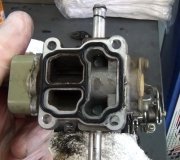By 2, I am assuming you mean 2000 RPM. This is high for the Civic as it should be around 800 RPM give or take a little. How long has it ran at 2000 RPMs at idle?
This is symptamatic of a vaccum leak.
There is a vaccum routing diagram under the hood of your car. This is not all of the places where it could be lleaking, but it is a good start. Other places that can leak are cruise controls, throttle body gasket and PCV valve. With the motor running you can hear a vaccum leak sometimes or you can put your hand over the throttle body and if it keeps running, it is a vac leak. From there a vacuum gauge is the best way to track down a vac leak.
Try that first and then by process of elimination, try the following;
A good place to start tracking down the problem would be to get some BG44K, if your local auto store does not have it you might have to go to a service station, and run it in a tank full of gas. If it improves from the BG44K, then run another can of it. The second can is just to remove heavy deposits if you don't normaly run an injector cleaner.
A standard tune up should at least include the following;
Replace the plugs, plug wires if they look like they need it, cap and rotor.
A can of injector cleaner.
Engine oil and filter using an OEM filter. I recomend OEM because it has an anti-drainback valve. Wait to replace the engine oil and filter until you have finished the tank of gas with the BG44K in it. It will clean up the intake and combustion chambers as well as valves, etc, so well that the oil will get dirty from the released deposits.
If this does not solve the problem, then you can start looking at the sensors.
I would first test the Throttle Position Sensor, (TPS), then Idle Air Control Valve, (IAC). Working by process of elimination is the only way to work through an electrical issue.
You need a mulitimeter and specs to perform these tests. I can find the specs online or you can get a Haynes manual which is handy as it will walk you through the steps and is a lot cheaper than the factory service manual. Although it is not as thourogh as the factory manual.
Good luck and let me know how it goes.
SPONSORED LINKS
Friday, September 24th, 2010 AT 7:00 PM



